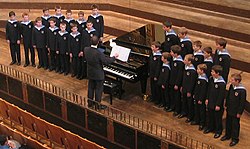Choir (music)
A choir or choral group is a collection of people who sing together. They typically rehearse together with a leader and perform concerts or sing during religious services. Some choirs are professional (the singers are paid for their work in the choir). Some choirs are semi-professional (the leaders are paid at a professional rate for their work with the choir but the singers are not). Some choirs are amateur or recreational (the leaders are either not paid or are offered an honorarium and the singers are not paid). Some amateur choirs invite anyone who is interested sing with them. Professional, semi-professional, and some amateur or recreational choirs require interested people to audition and then select their members based on a set of audition criteria.

Parts of a Choir
changeThe singers in choirs are grouped by their voice types and choral music is usually written with distinct lines or parts for some or all of these voice types. Voice types are typically organized into four groups. From highest vocal range to lowest, these include:
- Soprano (S): typically sung by higher-voiced, adult females or children
- Alto (A): typically sung by lower-voiced, adult females or children and less-typically by males who sing in their falsetto range
- Tenor (T): typically sung by higher-voiced, adult males
- Bass (B): typically sung by lower-voiced, adult males
Music composed for choirs, or choral music, usually has at least two distinct vocal lines or parts that create harmony with one another. Although four vocal ranges are typically specified, composers of choral music often write more than four vocal lines. If the music divides into more than four parts this subdivision is typically shown by repeating the initials of the four voice parts to show which singers should be assigned to these vocal lines, e.g. SSAATTBB (for music in eight parts: two soprano lines, two alto lines etc.). Young children’s choirs may be unison choirs (all singing the same line), but older children will sing in two (SS) or three (SSA) parts or more.
Types of Choirs
changeChoirs usually organize and limit themselves according to voicing and/or age of the singers as well as by the size of group or the type of music they sing.
The primary voicing categories are:
- A mixed choir is a group with changed (usually male) and unchanged voices (usually female or children); the voicing for this group is typically expressed as SATB (soprano, alto, tenor, bass).
- An equal voice choir is a group for either changed (usually male) voices or unchanged (usually female) voices. Sometimes these choirs are called men's choirs and women's/ladies' choirs. Sometimes they are referred to by their voicing: a TB or TTBB choir and an SA or SSAA choir.
- A youth choir varies widely in its voicing since adolescence is the period during which most male voices transition from the soprano or alto vocal range to the tenor or bass vocal range. For this reason, youth choirs can have any combination of voice parts, including SA, SAB, and SATB.
- A children’s choir is most typically an equal voice group for pre-pubertal singers. Some children's choirs also include youth and, therefore, may include changed voices (tenor and bass).
Choirs that organize themselves by size or repertoire type, they can be called:
- A chorus, choral society, or large ensemble is usually a choir of 40 or more singers and often includes 100+ people. These groups typically sing large works, including operas or oratorios or similar compositions.
- A chamber choir will never include more than 40 singers and will often be considerably smaller.
- A small vocal ensemble or vocal group typically ranges in size from 3 to 12 singers.
- An a cappella choir sings only music that has no pitched instrumental accompaniment.
- There are a vast number of choirs that organize themselves around specific cultural or religious music traditions.
Choir of a Church (Architectural)
changeThe word choir can also mean the part of a church or cathedral where the choir sit. The choir is between the nave (the main body of the church) and the sanctuary (where the altar is). The singers will divide into two groups and sit facing one another on either side of the choir area in the “choir stalls”. In cathedrals the singers on the left (when facing the altar) are called “cantoris” and those on the right are called “decani” (pronounce: dee-CAY-nye).
Choir of an Organ
changeA large pipe organ may have three or more manuals (keyboards). The third keyboard is called the "choir". Traditionally the sound from the choir organ comes from pipes in a separate box behind the organist, facing the choir (the singers). It is often used to accompany them. Originally it was a separate instrument so that the organist had to turn round to play it. Later it became possible for the organist to play it from the main console.
Some famous choirs
changeSome famous choirs include:
- San Francisco Symphony Chorus
- Mormon Tabernacle Choir
- Huddersfield Choral Society
- BBC Symphony Chorus
- BBC Singers
- Red Army Choir
- National Youth Choir of Great Britain
- Vienna Boys’ Choir (German: Wiener Sängerknaben)
- Harlem Boys’ Choir
- Choir of St John’s College, Cambridge
- Choir of Kings’ College, Cambridge
- Westminster Cathedral Choir
Other websites
changeMedia related to Choirs at Wikimedia Commons